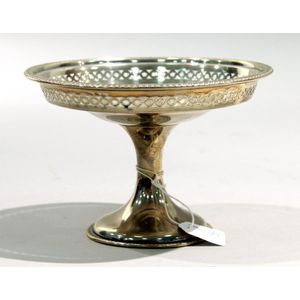Gilded Royal Worcester Tazza with Fruits and Woodland Scene
You must be a subscriber, and be logged in to view price and dealer details.
Subscribe Now to view actual auction price for this item
When you subscribe, you have the option of setting the currency in which to display prices to $Au, $US, $NZ or Stg.
- Gilding - Gilding is a method of ornamentation whereby a thin sheet of gold metal is applied to items made of wood, leather, ceramics, glass and silver for decorative purposes.
For furniture including mirrors, the sheet of gold is usually applied over a coating of gesso. Gesso is a mixture of plaster of Paris and gypsum mixed with water and then applied to the carved wooden frames of mirrors and picture frames as a base for applying the gold leaf. After numerous coats of gesso have been applied, allowed to dry and then sanded a coat of "bole", a usually red coloured mixture of clay and glue is brushed on and allowed to dry, after which the gold leaf is applied. Over time parts of the gilding will rub off so the base colour can be seen. In water gilding, this was generally a blue colour, while in oil gilding, the under layer was often yellow. In Victorian times, gilders frequently used red as a pigment beneath the gold leaf.
Metal was often gilded by a process known as fire gilding. Gold mixed with mercury was applied and heated, causing the mercury to evaporate, the long-term effect of which was to kill or disable the craftsman or woman from mercury poisoning. The pursuit of beauty has claimed many victims, not the least of which were the artists who made those pieces so highly sought after today. - Tazza - A tazza is a shallow saucer-like dish, either mounted on a stem and foot, or on a foot alone, used for drinking or serving small items of food. The word is derived from the Italian for "cup", plural tazze. Tazza are usually found in silver, ceramics or glass.
- Gadrooning - A series of lobes usually as a border. In furniture gadrooning is found as carved decoration around the edges of table tops in the Chippendale and Jacobean style furniture. Gadrooning is also found as decoration on the rims of silver and ceramics.
- Circa - A Latin term meaning 'about', often used in the antique trade to give an approximate date for the piece, usually considered to be five years on either side of the circa year. Thus, circa 1900 means the piece was made about 1900, probably between 1895 and 1905. The expression is sometimes abbreviated to c.1900.
This item has been included into following indexes:
- Freeman, John - Royal Worcester artists 74
- Royal Worcester (England), item types
Visually similar items

A Chinese cloisonne candlestick, late Qing (20th century), 13 cm high

A sterling silver stand dish on circular foot with gadrooned edges and pierced border. Sheffield 1913. Width 15.5 cm

Large and impressive Chinese cloisonne tazza or compote, 20th century, decorated with panels of Buddhist lions playing with a ribbon-tied brocade ball, and panels with stylised floral design, on a blue background with dense floral design. Height 36 cm. Pro

Bretby majolica glazed ceramic pedestal decorated with a larged pike fish, English, late 19th century. 72 cm
